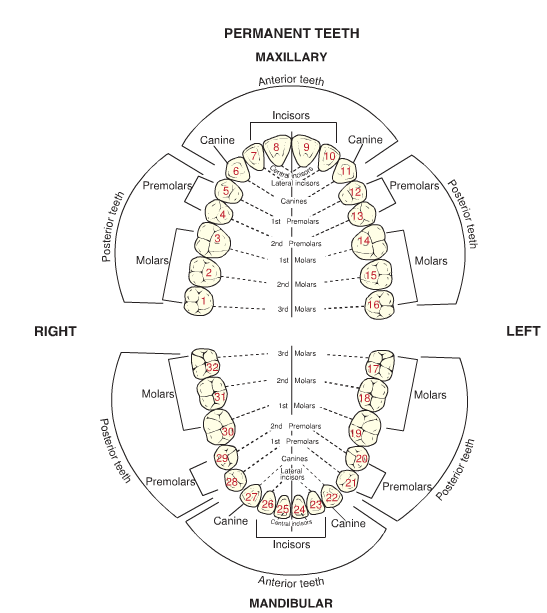Overview of Dental Anatomy
Dental anatomy is the study of the structure and development of teeth. Understanding dental anatomy is essential for diagnosing and treating dental issues, and for performing dental procedures effectively. This includes the morphology, function, and positional relationships of the teeth within the oral cavity.
Types of Teeth
- Incisors:
- Located at the front of the mouth.
- Have a sharp, chisel-shaped edge for cutting food.
- Each dental arch contains four incisors: two central and two lateral.
- Canines:
- Located at the corners of the dental arches.
- Have a pointed cusp for tearing food.
- Each dental arch contains two canines.
- Premolars (Bicuspids):
- Located behind the canines.
- Have two cusps for crushing and grinding food.
- Each dental arch contains four premolars: two on each side.
- Molars:
- Located at the back of the mouth.
- Have multiple cusps for grinding and chewing food.
- Each dental arch contains six molars: three on each side (including wisdom teeth).
Tooth Structure
- Crown:
- The visible part of the tooth above the gum line.
- Covered by enamel, the hardest substance in the body.
- Root:
- The part of the tooth embedded in the jawbone.
- Anchors the tooth in place and is covered by cementum.
- Enamel:
- The outermost layer of the crown.
- Highly mineralized and provides protection against decay.
- Dentin:
- The layer beneath the enamel and cementum.
- Contains microscopic tubules that can transmit sensation.
- Pulp:
- The innermost part of the tooth.
- Contains nerves, blood vessels, and connective tissue.
- Cementum:
- A calcified layer covering the root of the tooth.
- Helps anchor the tooth to the periodontal ligament.
- Periodontal Ligament:
- A group of specialized connective tissue fibers.
- Anchors the tooth to the alveolar bone and absorbs shock during chewing.
Dental Arches
- Maxillary Arch:
- The upper dental arch, part of the maxilla (upper jawbone).
- Mandibular Arch:
- The lower dental arch, part of the mandible (lower jawbone).
Primary vs. Permanent Dentition
- Primary Teeth (Deciduous Teeth):
- Also known as baby teeth or milk teeth.
- Total of 20 teeth: 10 in each arch.
- Typically begin to erupt at around 6 months of age.
- Eventually replaced by permanent teeth.
- Permanent Teeth:
- Also known as adult teeth.
- Total of 32 teeth: 16 in each arch (including wisdom teeth).
- Begin to erupt at around 6 years of age and continue through adolescence.
Occlusion and Alignment
- Occlusion:
- The contact relationship between the maxillary and mandibular teeth when the jaws are closed.
- Proper occlusion is crucial for effective chewing, speech, and overall oral health.
- Malocclusion:
- Misalignment of teeth or incorrect relation between the dental arches.
- Can lead to problems such as difficulty in chewing, speech issues, and increased risk of dental decay and gum disease.
Common Dental Conditions
- Dental Caries (Tooth Decay):
- Caused by bacterial activity that demineralizes the enamel and dentin.
- Gingivitis:
- Inflammation of the gums caused by plaque buildup.
- Can progress to periodontitis if left untreated.
- Periodontitis:
- Advanced gum disease affecting the periodontal ligament and alveolar bone.
- Can lead to tooth loss if untreated.
- Dental Abscess:
- Accumulation of pus caused by bacterial infection in the tooth or surrounding tissues.
- Requires prompt treatment to prevent spread of infection.
- Malocclusion:
- Improper alignment of the teeth and jaws.
- Can cause difficulty in biting, chewing, and speaking, as well as increase the risk of tooth decay and gum disease.
Dental Treatments
- Restorative Treatments:
- Fillings, crowns, bridges, and implants to repair or replace damaged or missing teeth.
- Orthodontic Treatments:
- Braces and aligners to correct malocclusion and improve tooth alignment.
- Periodontal Treatments:
- Scaling and root planing, gum grafts, and periodontal surgery to treat gum disease.
- Endodontic Treatments:
- Root canal therapy to treat infections of the tooth pulp.
- Prosthodontic Treatments:
- Design and fitting of dentures, bridges, and implants to restore function and aesthetics.
- Preventive Treatments:
- Regular dental check-ups, cleanings, fluoride treatments, and dental sealants to prevent dental diseases.
Summary
Dental anatomy encompasses the structure, function, and positional relationships of teeth within the oral cavity. Understanding the types of teeth, their structure, and common dental conditions is essential for effective diagnosis, treatment, and maintenance of oral health. Regular dental care and preventive measures play a crucial role in maintaining healthy teeth and gums.
